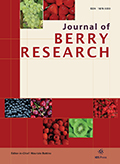Authors: Pluta, Stanisław | Żurawicz, Edward | Pruski, Kris
Article Type:
Research Article
Abstract:
The fruit quality of 10 blackcurrant genotypes of Polish origin (‘Bona’, ‘Gofert’, ‘Tines’, D13B/11 and PC-425 very recently named as ‘Tihope’) and Ukrainian (‘Chereshnieva’, ‘Yubylejnaia Kopania’, ‘Saniuta’, ‘Sofievskaia’ and ‘Vernisazh’) was evaluated in Central Poland in 2008–2010. The yield, fruit size (weight of 100 berries), the length of strigs and number of berries per strig, fruit firmness, soluble solids, content of ascorbic acids (vit. C), fruit appearance, taste and aroma as well as the shelf-life of fresh fruit in a room temperature were assessed. Results obtained in studies showed that new Polish cultivars ‘Tihope’ (PC-425) and ‘Gofert’ as well as
…Ukrainian cultivars ‘Jubilejnaja Kopania’ and ‘Vernisazh’ were the most productive and had the highest average fruit yield. The largest fruits produced the Polish breeding clone (D13B/11). Large fruits also had the standard cultivar ‘Bona’, cv. ‘Tihope’ (PC-425) and ‘Saniuta’. The highest number of fruit per strig was counted on Ukrainian cultivars (‘Chereshnieva’, ‘Yubylejnaia Kopania’, ‘Saniuta’) and Polish cv. ‘Gofert’. These cultivars also produced the longest strigs. The tested cultivars differed slightly in the attractiveness of the fruits. ‘Bona’ and ‘Tihope’ (PC-425) boasted the best appearance of fruits. Fruits of ‘Bona’ were found as the most flavorful. ‘Saniuta’, ‘Gofert’ and D13B/11 demonstrated only a little less taste and aroma. The best shelf-life of fruits possessed ‘Bona’, ‘Tihope’ (PC-425) and ‘Tines’. The firmest fruits were produced by ‘Chereshnieva’, ‘Tihope’ (PC-425), ‘Sofievskaia’ and ‘Gofert’. The highest content of soluble solids was found in fruit of ‘Gofert’ and ‘Tines’. The richest in vitamin C were fruits of ‘Gofert’, ‘Sofievskaia’ and ‘Tihope’ (PC-425).
Show more
Keywords: Blackcurrant, Ribes nigrum L., cultivars, dessert fruit quality, yield, fruit size, evaluation
DOI: 10.3233/JBR-2011-025
Citation: Journal of Berry Research,
vol. 2, no. 1, pp. 23-31, 2012





